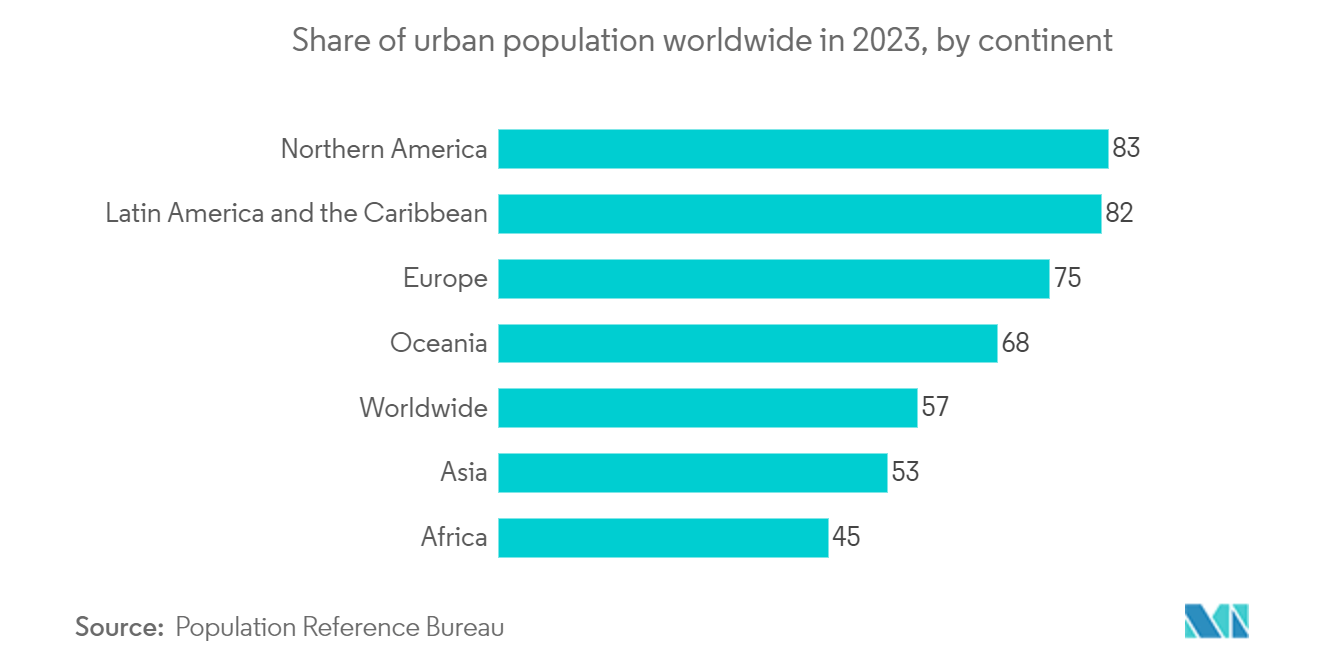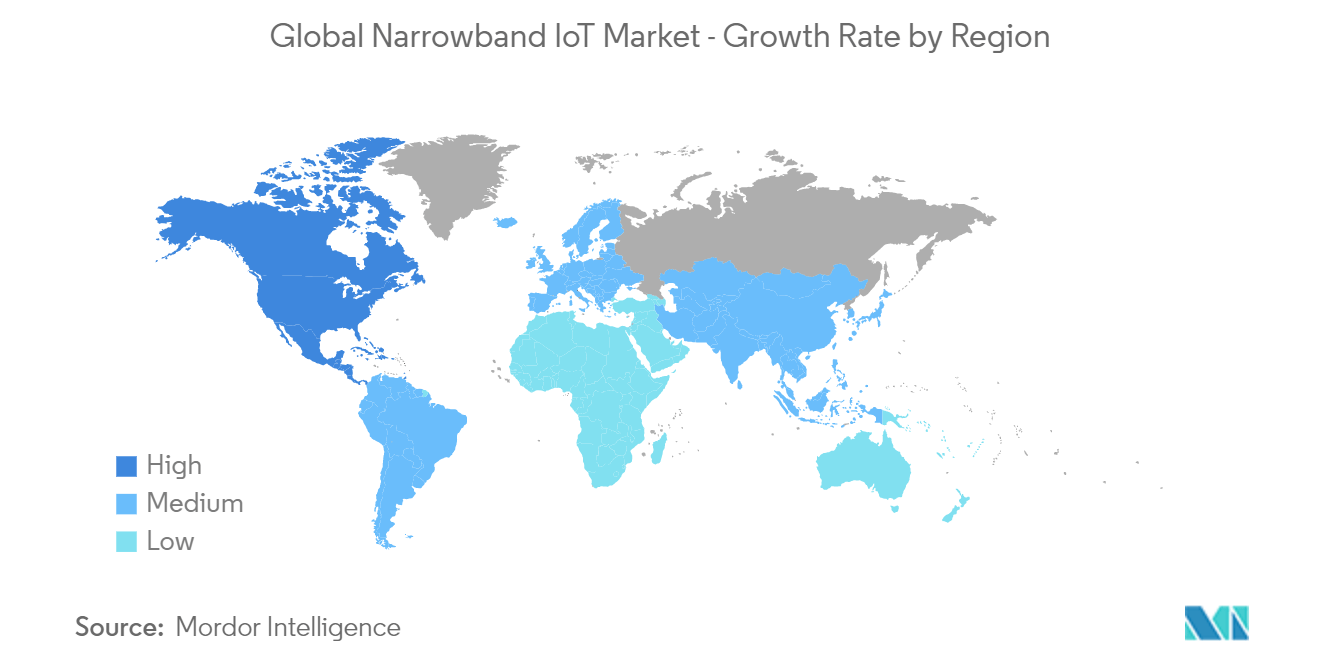Market Trends of Narrowband IoT Industry
Smart Cities is Expected to Drive the Market
- Advancements in mobile IoT networks solutions such as Nb-IoT from mobile operators offer a scalable, secure, and standardized way to connect smart city assets that offer a wide variety of services sustainably as they are particularly designed to meet the needs of smart city, the economics of using such technology is leading to improvement in value chain standardizes around networks and components.
- Additionally, in densely populated urban areas, cellular networks can manage traffic from a sizable number of IoT devices with little negative influence on network capacity. For instance, narrow band-IoT technology can handle a huge number of enormous IoT devices with little impact on network capacity, even in a dense metropolitan environment with 10,000 households per km2 and tens of thousands of installed IoT devices.
- The government's initiatives towards developing smart cities would allow the studied market to grow. For instance, in November 2022, the Smart Cities Council, a smart cities organization, began operations in the United Kingdom. The Smart Cities Council and its associated global impact program, "Everyone," bring together government, business, academia, philanthropy, and charity to take action and have an impact on the key challenges and possibilities that cities and communities face today. People, safety, beauty, sustainability, resilience, equity, and inclusion will be included in expanding "smart" from place and infrastructure in the United Kingdom.
- Further, According to the Union Housing and Urban Affairs Ministry, these Smart Cities recently bid out 6,452 projects totaling INR 1,84,998 crore. Work orders have been issued for 5,809 projects totaling INR 1,56,571 crore, with 3,131 projects totaling INR 53,175 crore completed. During the same period, the Central government provided INR 27,235 crore to states and union territories for smart city projects.
- According to the Economist group, Copenhagen was the leading worldwide digital city in 2022, according to the index rating above, with a score of 80.3. Seoul, Beijing, Amsterdam, and Singapore completed the top five list of best digital cities. With smart city initiatives, the trend of an increasing number of IoT and connected devices is expected to continue over the forecast period. The growing adoption of connected devices that include smart meters, smart homes, smart lighting, and smart transportation, among others that use IoT to connect, is likely to propel the growth of the studied market.
- By 2030, Saudi Arabia wants to have the most livable metropolis in the world, one that can draw the brightest brains and most talented people. To construct smart cities, the Kingdom has already set up USD 500 billion to invest across 285 municipalities. The nation is also constructing NEOM City, a futuristic 200 km long city with a wealth of cutting-edge technology that utilizes AI and IoT to the maximum.

North America Holds Major Market Share
- North America is home to several significant device makers and network service providers who focus on testing and commercial deployment of solutions for industrial and commercial applications, creating a massive demand for the industry. Additionally, the market is anticipated to contribute a sizeable share due to rising internet penetration, the continued rollout of high-speed internet infrastructure networks, the rise in smart city initiatives, and rising levels of disposable income, especially in economies like the United States, Canada, Brazil, and other nations in the region.
- The United States and Canada have developed economies that enable them to invest heavily in R&D. Rising digitization throughout the industrial emphasis areas, steady technological advancements, and rising penetration of smart connected devices have all contributed to the growth of the North American Narrowband IoT market. The increased usage of connected devices and associated network infrastructure, as well as the increased collaboration of network, hardware, and software providers, are the primary drivers that assist in expanding the IoT market in the North American region.
- According to Cisco, the United States and Canada are expected to have the highest average per capita devices and connections by 2022. Moreover, awareness about IoT devices in industries is significantly higher in the region compared to others. According to a study by Mendix, 78% of US manufacturing workers welcome digitalization; eight in ten manufacturing workers are interested in learning new digital skills. Such a rise in IoT devices would drive the demand for the studied market.
- In September 2022, The National Institute of Standards and Technology (NIST) issued Draft Security Recommendations for IoT Devices in the United States. Because IoT regularly poses a cybersecurity risk through hacks and data breaches, the NIST's Core Baseline highlights recommended security features for manufacturers to incorporate into their IoT devices and guidelines for consumers to look for on a device's box or online description while shopping.
- Companies like AT&T had launched NarrowBand IoT Network to cater to customers' business needs, providing them with a range of IoT offerings, including smart lighting solutions. Over the next 20 years, the cities in the country are planning to invest about USD 41 trillion to develop smart cities, smart energy, and other connected technologies, including smart lighting. According to the federal government, the Climate Smart Buildings Initiative is planned to boost performance contract spending from USD 251 million in FY2021 to USD 1.2 billion per year by 2030, a fivefold increase. Such a massive rise in spending on smart buildings would create several opportunities for the smart lighting players to develop new products to capture the market share.
- Many governments initiated smart lighting schemes with long-term goals in mind. Saint-Laurent, a borough of Montreal, Canada, launched an initiative to create a smart lighting system. The city saved 50% on energy expenditures, nearly 55% on maintenance costs, and reduced light pollution. Around 90% of the streetlamps on Saint-Laurent's roads have been replaced with LEDs. This replacement work was completed as part of numerous capital investment initiatives that the Ville de Montréal and the Arrondissement de Saint-Laurent run. The City of Montreal paid about USD 110 million in a project to replace 132,000 street lighting in 19 municipalities with LEDs. Such a rise in smart lighting is expected to create opportunities for the studied market to grow.


